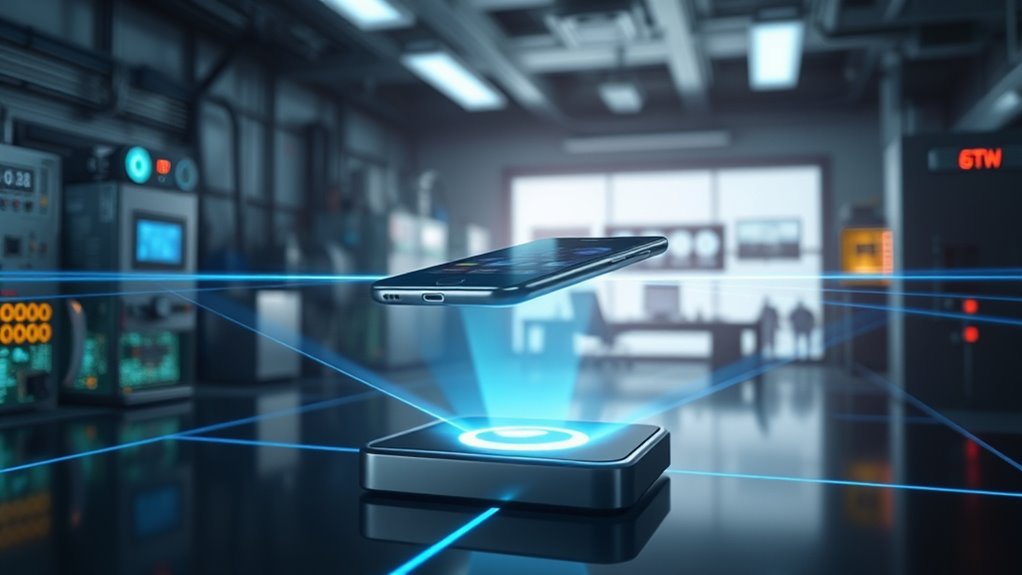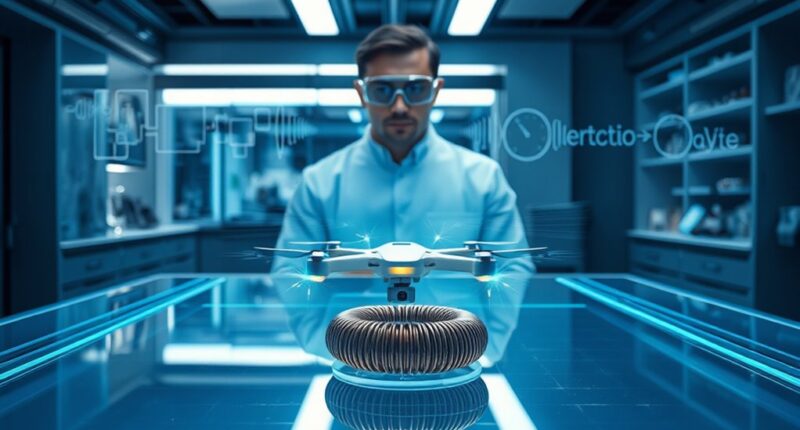Over-the-air wireless charging is rapidly progressing, using technologies like resonant coupling, beamforming, and advanced materials to transfer power without cables. While small devices and IoT gadgets can already benefit, achieving true long-distance wireless power remains a challenge due to efficiency and safety limits. Experts believe it could become mainstream within the next decade as innovations improve. If you stay curious, you’ll discover how ongoing research is shaping a future where devices charge effortlessly everywhere.
Key Takeaways
- Over-the-air charging uses technologies like resonant coupling and beamforming to wirelessly transfer energy without cords.
- Current limitations include efficiency loss over longer distances and safety concerns, hindering widespread adoption.
- Advances in materials, metamaterials, and electromagnetic focusing are improving transfer range and safety.
- Industry experts estimate true wireless power at scale may still take several years to overcome technical and regulatory challenges.
- Continued research and innovation are essential to achieve efficient, safe, and affordable wireless power for mainstream use.

Have you ever wondered how devices might charge without plugging in? Over-the-air charging makes that possible by transferring power wirelessly through the air, potentially over longer distances than traditional methods. Instead of connecting your phone or IoT device with a cable, this technology uses methods like infrared or resonant coupling to send energy directly through the air, offering a new level of convenience and flexibility. Imagine walking into your home and your devices automatically energize without any cords or docks—this is the promise of wireless power.
Imagine devices charging wirelessly in your home, no cords needed—just seamless, air-based power transfer.
The core principle involves different technologies working together to transmit energy efficiently. Infrared, similar to the remote controls you use, can direct power precisely to a device. Resonant coupling involves tuning coils to resonate at the same frequency, creating a more efficient transfer of energy over a distance. Electromagnetic induction, the basis of current wireless chargers, can be adapted for longer ranges, but it’s still limited. Beamforming, a technique that focuses energy into a narrow beam, helps direct power more accurately, reducing waste and increasing efficiency. Advanced materials like silver-plated copper or aluminum are also essential because they minimize weight and resistance, enhancing the overall energy transfer process. Research in metamaterials is exploring ways to improve wireless energy transfer over longer distances by manipulating electromagnetic waves more effectively. Additionally, ongoing innovations in wireless power transfer efficiency aim to overcome current limitations and make the technology more viable for everyday use.
This technology has a wide range of applications. For consumer electronics, it could mean charging your smartphone, earbuds, or gaming controllers wirelessly, reducing clutter and the need for multiple charging pads. IoT devices, such as sensors and smart home gadgets, could stay powered without frequent battery replacements or manual charging. Medical devices, including implants and medical carts, could benefit from continuous, hassle-free power. In industrial settings, robots, drones, and machinery could operate longer without interruptions, increasing productivity. Smart home systems could integrate over-the-air charging to create seamless, energy-efficient environments.
However, challenges remain. Achieving high efficiency over greater distances is difficult because energy loss increases as the transfer distance grows. Guaranteeing safety is paramount, requiring strict standards to prevent overheating or electrical hazards. Heat management and regulatory frameworks are crucial to protect users and the environment. Technological complexity, high costs, and scalability issues slow down widespread adoption. Compatibility among different devices and platforms still needs improvement, and ongoing research is imperative to overcoming these hurdles.
While initial deployments are starting to appear, true wireless power at scale isn’t here yet. Significant advancements are needed to extend range, improve efficiency, lower costs, and secure safety. The future of over-the-air charging looks promising, but it’s a developing field that requires continued innovation. When that breakthrough arrives, it could revolutionize how we power our devices, making wired charging a thing of the past.
Frequently Asked Questions
What Are the Potential Health Risks of Over-The-Air Charging?
You’re wondering about the health risks of over-the-air charging. While it emits electromagnetic fields, most exposure levels stay below safety guidelines. However, long-term effects like oxidative stress, DNA damage, and neurodevelopmental impacts are possible concerns. Symptoms such as headaches or fatigue might arise, especially with prolonged exposure. To stay safe, keep some distance from charging sources and follow manufacturer advice, as ongoing research continues to clarify these potential risks.
How Does Wireless Charging Impact Device Battery Lifespan?
Wireless charging impacts your device’s battery lifespan mainly through heat and charging cycles. The heat generated during wireless charging accelerates battery degradation, especially if you use thick cases or leave it charging too long. However, smart charging features help prevent overcharging. To extend your battery’s life, avoid prolonged charging sessions, remove thick cases, and monitor device temperature. Proper use minimizes wear and keeps your battery healthier over time.
Can Over-The-Air Charging Work Through Walls or Other Obstacles?
Ever wonder if wireless charging can work through walls? It can, thanks to recent advancements like resonant beam technology and magnetic resonance transfer, which allow power to permeate non-metallic obstacles. You should know that obstacle material, thickness, and signal attenuation affect efficiency. While non-metallic walls pose less challenge, metal or thick barriers markedly reduce performance. Safety measures ensure these systems operate without harming people or devices, making through-wall wireless charging increasingly feasible.
What Are the Environmental Implications of Widespread Wireless Power?
You’re wondering about the environmental implications of widespread wireless power. As you adopt this technology, you’ll notice it can lower carbon emissions, especially when integrated with renewable energy sources. It also reduces waste from cables and connectors. However, you should consider potential increases in electronic waste from new standards and infrastructure materials. Overall, if managed sustainably, wireless power can contribute markedly to greener transportation and energy systems.
How Secure Is Over-The-Air Charging From Hacking or Interference?
You’re right to be concerned about security in over-the-air charging. Currently, these systems face risks like hacking, interference, and unauthorized access because they often lack strong encryption and robust authentication. You should know that future developments aim to address these issues with advanced encryption, secure communication standards, and AI-powered monitoring. Staying informed and supporting industry efforts can help guarantee your devices remain safe from cyber threats.
Conclusion
As you can see, over-the-air charging is making impressive strides, but it’s not quite ready for everyday use. Experts predict that by 2030, wireless power could reach up to 30 feet, transforming how you power your devices. Imagine never needing to plug in again—it’s a future within reach. With current tech advancing rapidly, the possibility of truly wireless power isn’t just a dream; it’s approaching fast, promising greater convenience and innovation in your daily life.









